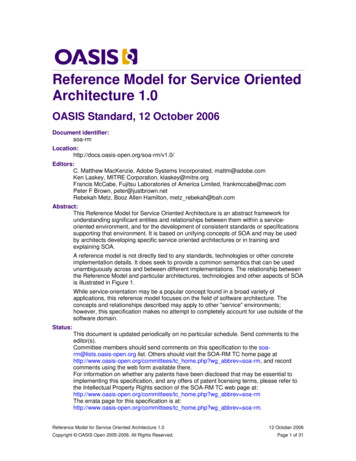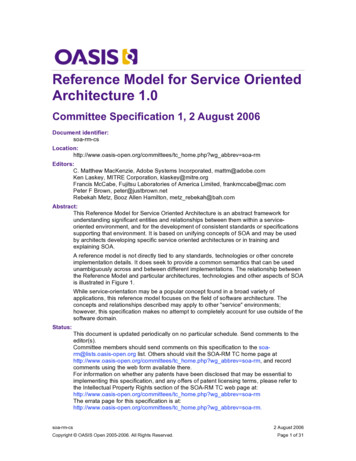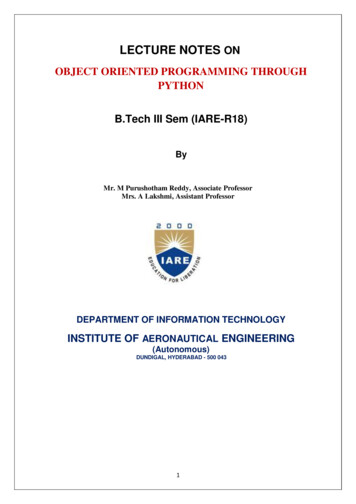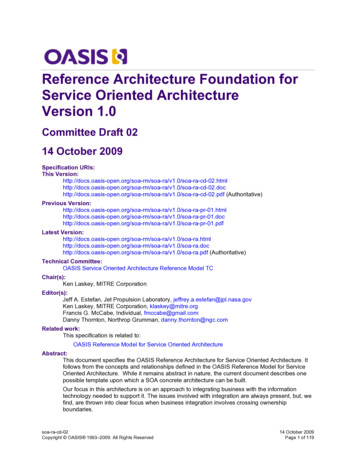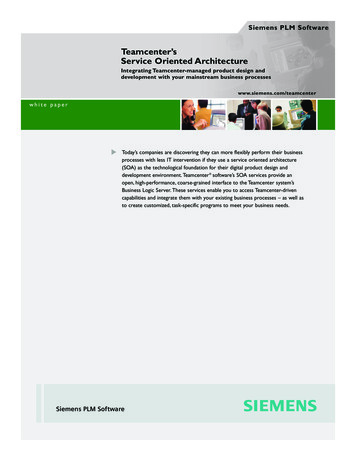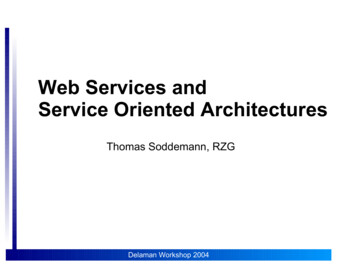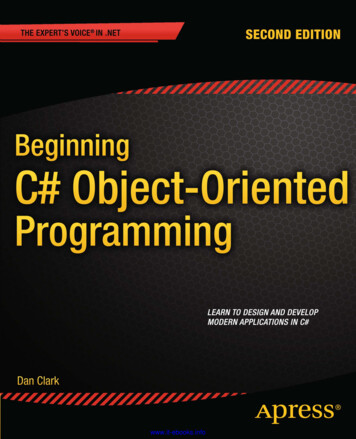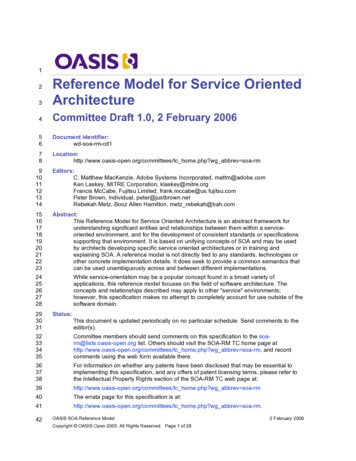
Transcription
13Reference Model for Service OrientedArchitecture4Committee Draft 1.0, 2 February 200656Document s-open.org/committees/tc home.php?wg abbrev soa-rm291011121314Editors:C. Matthew MacKenzie, Adobe Systems Incorporated, mattm@adobe.comKen Laskey, MITRE Corporation, klaskey@mitre.orgFrancis McCabe, Fujitsu Limited, frank.mccabe@us.fujitsu.comPeter Brown, Individual, peter@justbrown.netRebekah Metz, Booz Allen Hamilton, metz rebekah@bah.com151617181920212223Abstract:This Reference Model for Service Oriented Architecture is an abstract framework forunderstanding significant entities and relationships between them within a serviceoriented environment, and for the development of consistent standards or specificationssupporting that environment. It is based on unifying concepts of SOA and may be usedby architects developing specific service oriented architectures or in training andexplaining SOA. A reference model is not directly tied to any standards, technologies orother concrete implementation details. It does seek to provide a common semantics thatcan be used unambiguously across and between different implementations.2425262728293031While service-orientation may be a popular concept found in a broad variety ofapplications, this reference model focuses on the field of software architecture. Theconcepts and relationships described may apply to other "service" environments;however, this specification makes no attempt to completely account for use outside of thesoftware domain.Status:This document is updated periodically on no particular schedule. Send comments to theeditor(s).32333435Committee members should send comments on this specification to the soarm@lists.oasis-open.org list. Others should visit the SOA-RM TC home page athttp://www.oasis-open.org/committees/tc home.php?wg abbrev soa-rm, and recordcomments using the web form available there.363738For information on whether any patents have been disclosed that may be essential toimplementing this specification, and any offers of patent licensing terms, please refer tothe Intellectual Property Rights section of the SOA-RM TC web page at:39http://www.oasis-open.org/committees/tc home.php?wg abbrev soa-rm40The errata page for this specification is at:41http://www.oasis-open.org/committees/tc home.php?wg abbrev soa-rm.42OASIS SOA Reference ModelCopyright OASIS Open 2005. All Rights Reserved. Page 1 of 282 February 2006
6768697071Table of Contents1Introduction. 31.1 What is a reference model . 31.2 A Reference Model for Service Oriented Architectures. 31.3 Audience . 41.4 Guide to using the reference model . 51.5 Notational Conventions . 51.6 Relationships to Other Standards . 52 Service Oriented Architecture . 62.1 What is Service Oriented Architecture? . 62.1.1 A worked Service Oriented Architecture example. 72.2 How is Service Oriented Architecture different? . 82.3 The Benefits of Service Oriented Architecture . 83 The Reference Model . 93.1 Service. 93.2 Dynamics of Services. 103.2.1 Visibility. 103.2.2 Interacting with services . 123.2.3 Real World Effect . 153.3 About services . 163.3.1 Service description . 173.3.2 Policies and Contracts. 193.3.3 Execution context. 214 Conformance Guidelines. 225 References . 235.1 Normative . 235.2 Non-Normative. 23Appendix A. Glossary. 24Appendix B. Acknowledgments. 27Appendix C. Notices. 2872OASIS SOA Reference ModelCopyright OASIS Open 2005. All Rights Reserved. Page 2 of 282 February 2006
731 Introduction747576777879The notion of Service Oriented Architecture (SOA) has received significant attention withinthe software design and development community. The result of this attention is theproliferation of many conflicting definitions of SOA. Whereas SOA architectural patterns (orreference architectures) may be developed to explain and underpin a generic designtemplate supporting a specific SOA, a reference model is intended to provide an evenhigher level of commonality, with definitions that should apply to all SOA.801.1 What is a reference model818283848586A reference model is an abstract framework for understanding significant relationshipsamong the entities of some environment. It enables the development of specificarchitectures using consistent standards or specifications supporting that environment. Areference model consists of a minimal set of unifying concepts, axioms and relationshipswithin a particular problem domain, and is independent of specific standards, technologies,implementations, or other concrete details.87888990919293As an illustration of the relationship between a reference model and the architectures that canderive from such a model, consider what might be involved in modeling what is important aboutresidential housing. In the context of a reference model, we know that concepts such as eatingareas, hygiene areas and sleeping areas are all important in understanding what goes into ahouse. There are relationships between these concepts, and constraints on how they areimplemented. For example, there may be physical separation between eating areas and hygieneareas.949596979899The role of a reference architecture for housing would be to identify abstract solutions to theproblems of providing housing. A general pattern for housing, one that addresses the needs of itsoccupants in the sense of, say, noting that there are bedrooms, kitchens, hallways, and so on is agood basis for an abstract reference architecture. The concept of eating area is a referencemodel concept, a kitchen is a realization of eating area in the context of the referencearchitecture.100101102103104105There may be more than one reference architecture that addresses how to design housing; forexample, there may be a reference architecture to address the requirements for developinghousing solutions in large apartment complexes, another to address suburban single familyhouses, and another for space stations. In the context of high density housing, there may not bea separate kitchen but rather a shared cooking space or even a communal kitchen used by manyfamilies.106107108109An actual – or concrete – architecture would introduce additional elements. It would incorporateparticular architectural styles, particular arrangements of windows, construction materials to beused and so on. A blueprint of a particular house represents an instantiation of an architecture asit applies to a proposed or actually constructed dwelling.110111112113The reference model for housing is, therefore, at least three levels of abstraction away from aphysical entity that can be lived in. The purpose of a reference model is to provide a commonconceptual framework that can be used consistently across and between differentimplementations and is of particular use in modeling specific solutions.1141.2 A Reference Model for Service Oriented Architectures115116117118The goal of this reference model is to define the essence of service oriented architecture, andemerge with a vocabulary and a common understanding of SOA. It provides a normativereference that remains relevant for SOA as an abstract and powerful model, irrespective of thevarious and inevitable technology evolutions that will influence SOA deployment.OASIS SOA Reference ModelCopyright OASIS Open 2005. All Rights Reserved. Page 3 of 282 February 2006
119120121122123124Figure 1 shows how a reference model for SOA relates to other distributed systemsarchitectural inputs. The concepts and relationships defined by the reference model areintended to be the basis for describing references architectures and patterns that will definemore specific categories of SOA designs. Concrete architectures arise from a combinationof reference architectures, architectural patterns and additional requirements, includingthose imposed by technology environments.125126127128Architecture is not done in isolation but must account for the goals, motivation, andrequirements that define the actual problems being addressed. While referencearchitectures can form the basis of classes of solutions, concrete architectures will definespecific solution approaches.129130Architecture is often developed in the context of a pre-defined environment, such as theprotocols, profiles, specifications, and standards that are pertinent.131132133SOA implementations combine all of these elements, from the more generic architecturalprinciples and infrastructure to the specifics that define the current needs, and representspecific implementations that will be built and used in an operational environment.134135Figure 1 How the Reference Model relates to other work1361.3 Audience137The intended audiences of this document include non-exhaustively:138139140141142143144145 Architects and developers designing, identifying or developing a system based on theservice-oriented paradigm.Standards architects and analysts developing specifications that rely on service orientedarchitecture concepts.Decision makers seeking a "consistent and common" understanding of service orientedarchitectures.Users who need a better understanding of the concepts and benefits of service orientedarchitecture.OASIS SOA Reference ModelCopyright OASIS Open 2005. All Rights Reserved. Page 4 of 282 February 2006
1461.4 Guide to using the reference model147148New readers are encouraged to read this reference model in its entirety. Concepts are presentedin an order that the authors hope promote rapid understanding.149150151This section introduces the conventions, defines the audience and sets the stage for the rest ofthe document. Non-technical readers are encouraged to read this information as it providesbackground material necessary to understand the nature and usage of reference models.152153154155156Section 2 introduces the concept of SOA and identifies some of the ways that it differs fromprevious paradigms for distributed systems. Section 2 offers guidance on the basic principles ofservice oriented architecture. This can be used by non-technical readers to gain an explicitunderstanding of the core principles of SOA and by architects as guidance for developing specificservice oriented architectures.157158159160161162Section 3 introduces the Reference Model for SOA. In any framework as rich as SOA, it is difficultto avoid a significant amount of cross referencing between concepts. This makes presentation ofthe material subject to a certain amount of arbitrariness. We resolve this by introducing theconcept of service itself, then we introduce concepts that relate to the dynamic aspects of serviceand finally we introduce those concepts that refer to the meta-level aspects of services such asservice description and policies as they apply to services.163Section 4 addresses compliance with this reference model.164165166The glossary provides definitions of terms that are relied upon within the reference modelspecification but do not necessarily form part of the specification itself. Terms that are defined inthe glossary are marked in bold at their first occurrence in the document.167168169170171Note that while the concepts and relationships described in this reference model may apply toother "service" environments, the definitions and descriptions contained herein focus on the fieldof software architecture and make no attempt to completely account for use outside of thesoftware domain. Examples included in this document that are taken from other domains areused strictly for illustrative purposes.1721.5 Notational Conventions173174175The key words MUST, MUST NOT, REQUIRED, SHALL, SHALL NOT, SHOULD, SHOULD NOT,RECOMMENDED, MAY, and OPTIONAL in this document are to be interpreted as described in[RFC2119].176References are surrounded with [square brackets and are in bold text].1771.6 Relationships to Other Standards178Due to its nature, this reference model may have an implied relationship with any group that:179 Considers its work "service oriented";180181 Makes (publicly) an adoption statement to use the Reference Model for SOA as a base orinspiration for their work; and182 Standards or technologies that claim to be service oriented.183184The reference model does not endorse any particular service-oriented architecture, or attest tothe validity of third party reference model conformance claims.OASIS SOA Reference ModelCopyright OASIS Open 2005. All Rights Reserved. Page 5 of 282 February 2006
1852 Service Oriented Architecture1862.1 What is Service Oriented Architecture?187188Service Oriented Architecture (SOA) is a paradigm for organizing and utilizing distributedcapabilities that may be under the control of different ownership domains.189190191192193In general, entities (people and organizations) create capabilities to solve or support a solutionfor the problems they face in the course of their business. It is natural to think of one person’sneeds being met by capabilities offered by someone else; or, in the world of distributedcomputing, one computer agent’s requirements being met by a computer agent belonging to adifferent owner.194195196197198There is not necessarily a one-to-one correlation between needs and capabilities; the granularityof needs and capabilities vary from fundamental to complex, and any given need may require thecombining of numerous capabilities while any single capability may address more than one need.The perceived value of SOA is that it provides a powerful framework for matching needs andcapabilities and for combining capabilities to address those needs.199200201202203204Visibility, interaction, and effect are key concepts for describing the SOA paradigm. Visibilityrefers to the capacity for those with needs and those with capabilities to be able to see eachother. This is typically done by providing descriptions for such aspects as functions and technicalrequirements, related constraints and policies, and mechanisms for access or response. Thedescriptions need to be in a form (or can be transformed to a form) in which their syntax andsemantics are widely accessible and understandable.205206207208209210211Whereas visibility introduces the possibilities for matching needs to capabilities (and vice versa),interaction is the activity of using a capability. Typically mediated by the exchange of messages,an interaction proceeds through a series of information exchanges and invoked actions. Thereare many facets of interaction; but they are all grounded in a particular execution context – theset of technical and business elements that form a path between those with needs and those withcapabilities. This permits service providers and consumers to interact and provides a decisionpoint for any policies and contracts that may be in force.212213214215216217218The purpose of using a capability is to realize one or more real world effects. At its core, aninteraction is “an act” as opposed to “an object” and the result of an interaction is an effect (or aset/series of effects). We are careful to distinguish between public actions and private actions;private actions are inherently unknowable by other parties. On the other hand, public actionsresult in changes to the state that is shared at least between those involved in the currentexecution context and possibly shared by others. Real world effects are, then, couched in termsof changes to this shared state.219220221222223The expected real world effects form an important part of the decision on whether a givencapability matches similarly described needs. At the interaction stage, the description of realworld effects establishes the expectations of those using the capability. Note, it is not possibleto describe every effect from using a capability, a cornerstone of SOA is that we can usecapabilities without needing to know all the details.224225226227To this point, this description of SOA has yet to mention what is usually considered the centralconcept: the service. The noun “service” is defined in dictionaries as “The performance of work(a function) by one for another.” However, service, as the term is generally understood, alsocombines the following related ideas:228 The capability to perform work for another229 The specification of the work offered for another230 The offer to perform work for anotherOASIS SOA Reference ModelCopyright OASIS Open 2005. All Rights Reserved. Page 6 of 282 February 2006
231232233These concepts emphasize a distinction between a capability and the ability to bring thatcapability to bear. While both needs and capabilities exist independently of SOA, in SOA,services are the mechanism by which needs and capabilities are brought together.234235236237238239SOA is a means of organizing solutions that promotes reuse, growth and interoperability. It is notitself a solution to domain problems but rather an organizing and delivery paradigm that enablesone to get more value from use both of capabilities which are locally “owned” and those under thecontrol of others. It also enables one to express solutions in a way that makes it easier to modifyor evolve the identified solution or to try alternate solutions. SOA does not provide any domainelements of a solution that do not exist without SOA.240241242243244245The concepts of visibility, interaction, and effect apply directly to services in the same manner asthese were described for the general SOA paradigm. Visibility is promoted through the servicedescription which contains the information necessary to interact with the service and describesthis in such terms as the service inputs, outputs, and associated semantics. The servicedescription also conveys what is accomplished when the service is invoked and the conditions forusing the service.246247248249In general, entities (people and organizations) offer capabilities and act as service providers.Those with needs who make use of services are referred to as service consumers. The servicedescription allows prospective consumers to decide if the service is suitable for their currentneeds and establishes whether a consumer satisfies any requirements of the service provider.250251(Note, service providers and service consumers are sometimes referred to jointly as serviceparticipants.)252253254255256257258In most discussions of SOA, the terms “loose coupling” and “coarse-grained” are commonlyapplied as SOA concepts, but these terms have intentionally not been used in the currentdiscussion because they are subjective trade-offs and without useful metrics. In terms of needsand capabilities, granularity and coarseness are usually relative to detail for the level of theproblem being addressed, e.g. one that is more strategic vs. one down to the algorithm level, anddefining the optimum level is not amenable to counting the number of interfaces or the number ortypes of information exchanges connected to an interface.259260261262263Note that although SOA is commonly implemented using Web services, services can be madevisible, support interaction, and generate effects through other implementation strategies. Webservice-based architectures and technologies are specific and concrete. While the concepts in theReference Model apply to such systems, Web Services are too solution specific to be part of ageneral reference model.2642.1.1 A worked Service Oriented Architecture example265266267268269270271272273An electric utility has the capacity to generate and distribute electricity (the underlying capability).The wiring from the electric company’s distribution grid (the service) provides the means to supplyelectricity to support typical usage for a residential consumer’s house (service functionality), anda consumer accesses electricity generated (the output of invoking the service) via a wall outlet(service interface). In order to use the electricity, a consumer needs to understand what type ofplug to use, what is the voltage of the supply, and possible limits to the load; the utility presumesthat the customer will only connect devices that are compatible with the voltage provided and loadsupported; and the consumer in turn assumes that compatible consumer devices can beconnected without damage or harm (service technical assumptions).274275276277278279280A residential or business user will need to open an account with the utility in order to use thesupply (service constraint) and the utility will meter usage and expects the consumer to pay foruse at the rate prescribed (service policy). When the consumer and utility agree on constraintsand polices (service contract), the consumer can receive electricity using the service as long asthe electricity distribution grid and house connection remain intact (e.g. a storm knocking downpower lines would disrupt distribution) and the consumer can have payment sent (e.g. a check bymail or electronic funds transfer) to the utility (reachability).OASIS SOA Reference ModelCopyright OASIS Open 2005. All Rights Reserved. Page 7 of 282 February 2006
281282283284Another person (for example, a visitor to someone else's house) may use a contracted supplywithout any relationship with the utility or any requirement to also satisfy the initial serviceconstraint (i.e. reachability only requires intact electricity distribution) but would nonetheless beexpected to be compatible with the service interface.285286287In certain situations (for example, excessive demand), a utility may limit supply or institute rollingblackouts (service policy). A consumer might lodge a formal complaint if this occurred frequently(consumer's implied policy).288289290If the utility required every device to be hardwired to its equipment, the underlying capabilitywould still be there but this would be a very different service and have a very different serviceinterface.2912.2 How is Service Oriented Architecture different?292293294295Unlike Object Oriented Programming paradigms, where the focus is on packaging data withoperations, the central focus of Service Oriented Architecture is the task or business function –getting something done. This is a more viable basis for large scale systems because it is a betterfit to the way human activity itself is managed – by delegation.296297298How does this paradigm of SOA differ from other approaches to organizing and understandingInformation Technology assets? Essentially, there are two areas in which it differs both of whichshape the framework of concepts that underlie distributed systems.299300301302303304305306First, SOA reflects the reality that ownership boundaries are a motivating consideration in thearchitecture and design of systems. This recognition is evident in the core concepts of visibility,interaction and effect. However, SOA does not itself address all the concepts associated withownership, ownership domains and actions communicated between legal peers. To fully accountfor concepts such as trust, business transactions, authority, delegation and so on – additionalconceptual frameworks and architectural elements are required. Within the context of SOA,these are likely to be represented and referenced within service descriptions and serviceinterfaces.307308309310311312Second, SOA applies the lessons learned from commerce to the organization of IT assets tofacilitate the matching of capabilities and needs. That two or more entities come together withinthe context of a single interaction implies the exchange of some type of value. This is the samefundamental basis as trade itself, and suggests that as SOAs evolve away from interactionsdefined in a point-to-point manner to a marketplace of services; the technology and concepts canscale as successfully as the commercial marketplace.3132.3 The Benefits of Service Oriented Architecture314315316The main drivers for SOA-based architectures are to facilitate the manageable growth of largescale enterprise systems, to facilitate Internet-scale provisioning and use of services and toreduce costs in organization to organization cooperation.317318319320The value of SOA is that it provides a simple scalable paradigm for organizing large networks ofsystems that require interoperability to realize the value inherent in the individual components.Indeed, SOA is scalable because it makes the fewest possible assumptions about the networkand also minimizes any trust assumptions that are often implicitly made in smaller scale systems.321322323324An architect using SOA principles is better equipped, therefore, to develop systems that arescalable, evolvable and manageable. It should be easier to decide how to integrate functionalityacross ownership boundaries. For example, a large company that acquires a smaller companymust determine how to integrate the acquired IT infrastructure into its overall IT portfolio.325326327328329Through this inherent ability to scale and evolve, SOA enables an IT portfolio which is alsoadaptable to the varied needs of a specific problem domain or process architecture. Theinfrastructure SOA encourages is also more agile and responsive than one built on anexponential number of pair-wise interfaces. Therefore, SOA can also provide a solid foundationfor business agility and adaptability.OASIS SOA Reference ModelCopyright OASIS Open 2005. All Rights Reserved. Page 8 of 282 February 2006
3303 The Reference Model331332Figure 2 illustrates the principal concepts this reference model defines. The relationships betweenthem are developed as each concept is defined in turn.333334Figure 2 Principal concepts in the Reference Model3353.1 Service336337338339340341A service is a mechanism to enable access to a set of one or more capabilities, where theaccess is provided using a prescribed interface and is exercised consistent with constraints andpolicies as specified by the service description. A service is provided by one entity – the serviceprovider – for use by others, but the eventual consumers of the service may not be known to theservice provider and may demonstrate uses of the service beyond the scope originally conceivedby the provider.342343344345346A service is accessed by means of a service interface (see Section 3.3.1.4), where the interfacecomprises the specifics of how to access the underlying capabilities. There are no constraints onwhat constitutes the underlying capability or how access is implemented by the service provider.Thus, the service could carry out its described functionality through one or more automatedand/or manual processes that themselves could invoke other available services.347348349350A service is opaque in that its implementation is typically hidden from the service consumerexcept for (1) the information and behavior models exposed through the service interface and (2)the information required by service consumers to determine whether a given service isappropriate for their needs.351352The consequence of invoking a service is a realization of one or more real world effects (
154 service oriented architecture. This can be used by non-technical readers to gain an explicit 155 understanding of the core principles of SOA and by architects as guidance for developing specific 156 service oriented architectures. 157 Section 3 introduces the Reference Model
